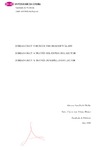Mostrar o rexistro simple do ítem
Dorian Gray through the Reader's Glass
| dc.contributor.advisor | Gómez Blanco, Carlos J. | |
| dc.contributor.author | Mallo Meilán, Sara | |
| dc.contributor.other | Universidade da Coruña. Facultade de Filoloxía | es_ES |
| dc.date.accessioned | 2021-03-08T10:38:03Z | |
| dc.date.available | 2021-03-08T10:38:03Z | |
| dc.date.issued | 2020 | |
| dc.identifier.uri | http://hdl.handle.net/2183/27432 | |
| dc.description.abstract | [Abstract] Oscar Wilde’s sole novel, The Picture of Dorian Gray, was first published in 1890 in Lippincott’s Monthly Magazine and deemed by many of his peers as an immoral work; despite the censorship imposed by the magazine’s editor without consulting Wilde on the matter. Wilde however defended his work and stance thoroughly against his critics. This is particularly evident in the very preface of the book; but what is it that could have possibly been so impactful for the readers? What is it that Wilde is trying to defend so unrelentingly? It is the aim of this work to comprehend the relation in between text and audience, which seemed to spark so much debate; by analysing its contents, characters and its own gothic elements, and the effect they can possibly cause in its audience. This will be studied with the aid of “Reader Response Theory” and it shall help determine whether Wilde may have met his objective or if, as many believed, failed miserably by getting to carried away with his aesthetic ideal. The analysis will be based on the approach of authors such as Wolfgang Iser and, to a lesser extent, Stanley Fish. By following their, and Wilde’s, recommendations it can truly be proven how the text is specifically constructed in a way that, without argument, does indeed amuse and inspire both horror and beauty to the audience. But most importantly by using a purposeful ambiguity in significant instances, the text does force the reader to create a judgement of their own. Therefore, showing a great capacity to design a very personal narrative experience and to reveal more about the individual than they may have immediately thought of; and yet, the text is capable at the same time of showing the author’s true intentions with well-placed hints for the more receptive readers. | es_ES |
| dc.language.iso | eng | es_ES |
| dc.rights | Os titulares dos dereitos de propiedade intelectual autorizan a visualización do contido deste traballo a través de Internet, así como a súa reproducción, gravación en soporte informático ou impresión para o seu uso privado e/ou con fins de estudo e de investigación. En nengún caso se permite o uso lucrativo deste documento. Estos dereitos afectan tanto ó resumo do traballo como o seu contido Los titulares de los derechos de propiedad intelectual autorizan la visualización del contenido de este trabajo a través de Internet, así como su repoducción, grabación en soporte informático o impresión para su uso privado o con fines de investigación. En ningún caso se permite el uso lucrativo de este documento. Estos derechos afectan tanto al resumen del trabajo como a su contenido | es_ES |
| dc.subject | Wilde, Oscar | es_ES |
| dc.subject | Readers Response Theory | es_ES |
| dc.subject | Readers | es_ES |
| dc.subject | Aesthetic | es_ES |
| dc.subject | The Picture of Dorian Gray | es_ES |
| dc.title | Dorian Gray through the Reader's Glass | es_ES |
| dc.title.alternative | Dorian Gray a través del espejo del lector | es_ES |
| dc.title.alternative | Dorian Gray a través do espello do lector | es_ES |
| dc.type | info:eu-repo/semantics/bachelorThesis | es_ES |
| dc.rights.access | info:eu-repo/semantics/openAccess | es_ES |
| dc.description.traballos | Traballo fin de grao (UDC.FIL). Inglés: estudios lingüísticos y literarios. Curso 2019/2020 | es_ES |






